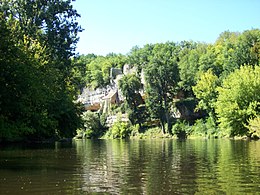Vézère
Vézère
River in France
The Vézère (French pronunciation: [vezɛʁ]; Occitan: Vesera) is a 211-km-long river in southwestern France. It is an important tributary to the Dordogne.[1] Its source is in the northwestern part of the elevated plateau known as the Massif Central. It flows into the Dordogne from the right near Le Bugue. The river Corrèze is a tributary of the Vézère.
You can help expand this article with text translated from the corresponding article in French. (April 2018) Click [show] for important translation instructions.
|

The Vézère Valley is famed for its prehistoric cave systems, containing numerous cave paintings and hominid remains. UNESCO collectively designated these a World Heritage Site in 1979. Among the sites with remarkable caves is Lascaux.


